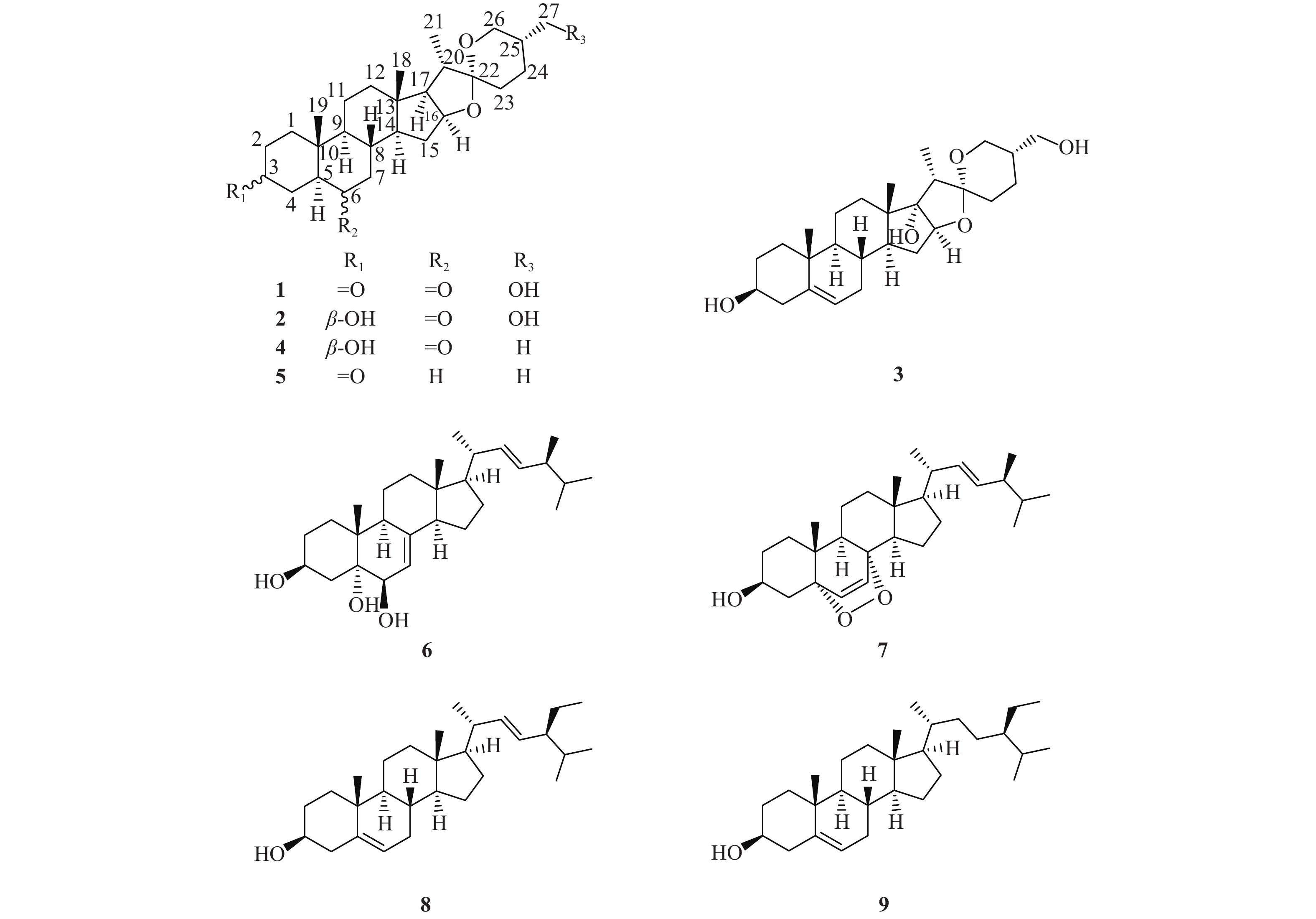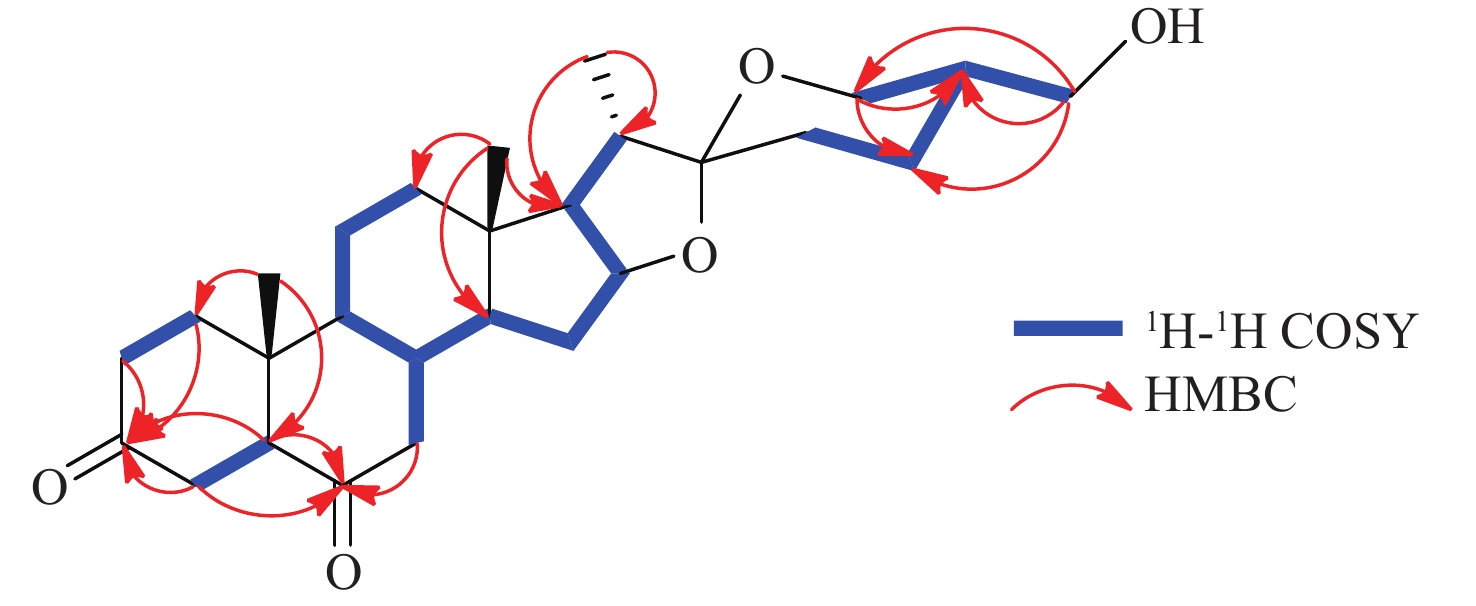Chemical constituents from the stems of Fritillaria unibracteata
-
摘要:
采用硅胶及制备HPLC等柱色谱方法对暗紫贝母 (Fritillaria unibracteata P.K. Hsiao & K.C. Hsia) 茎乙醇提取物的化学成分进行分离纯化,通过NMR、ESI-MS等波谱技术鉴定化合物结构,分离鉴定了9个化合物,分别为:27-hydroxychlorogenone (1), sieboldogenin (2), (3β, 25S)-spirost-5-ene-3,17,27-triol (3), 拉肖皂苷元 (4), 替告皂苷元酮 (5), 啤酒甾醇 (6), 过氧化麦角甾醇 (7), 豆甾醇 (8), β-谷甾醇 (9)。其中化合物1为新化合物,化合物2~9均为首次从暗紫贝母茎中分离得到。体外活性初步评价了化合物1~9对A549细胞的细胞毒活性,结果显示,化合物6具有中等强度的细胞毒活性,IC50为(14.16±1.11)μmol/L。
Abstract:Chemical investigation of the stems of Fritillaria unibracteata P.K. Hsiao & K.C. Hsia resulted in the isolation of nine compounds, by means of silica gel column chromatography, and preparative HPLC. Based on spectroscopic and chemical evidence, these compounds were identified as: 27-hydroxychlorogenone (1), sieboldogenin (2), (3β, 25S)-spirost-5-ene-3,17,27-triol (3), laxogenin (4), tigogenone (5), cerevisterol (6), ergosterol peroxide (7), stigmaterol (8), and β-sitosterol (9). Compound 1 was a new compound, and compounds 2-9 were isolated from the stems of Fritillaria unibracteata for the first time. The inhibitory effects of compounds 1−9 on A549 cells were determined using the MTT method. The results show that compound 6 exhibits moderate inhibitory activity with an IC50 value of (14.16 ± 1.11) μmol/L.
-
Keywords:
- Fritillaria unibracteata /
- stem /
- steroid /
- chemical constituents; cytotoxicity
-
-
Table 1 NMR data of compound 1a
Positon δH b δC c HMBC 1 1.62, 2.13, m 38.1 C-3, 5 2 2.04, 2.35, m 37.0 C-1, 3, 5, 10 3 211.0 4 2.07, 2.43, m 37.5 C-2, 3, 5, 6 5 2.59, m 57.5 C-3, 6, 10, 19 6 208.7 7 2.03, m
2.41, dd (16.0, 6.1)46.6 C-6, 9 8 1.65, m 37.3 9 1.37, m 53.4 10 41.2 11 1.46, 1.67, m 21.5 12 1.26, 1.83, m 39.4 C-9, 11, 18 13 41.0 14 1.38, m 56.3 C-8 15 1.30, 1.36, m 31.6 C-14, 16 16 4.43, 1H, td (7.9, 5.8) 80.4 C-13 17 1.84, m 62.0 C-12, 14, 16, 18, 20, 21 18 0.80, 3H, s 16.4 C-12, 14, 17 19 0.98, 3H, s 12.6 C-1, 5, 9, 10 20 1.91, m 41.7 C-17 21 0.99, 3H, d (7.0) 14.4 C-17, 20, 22 22 109.5 23 1.68, 1.95, m 30.7 C-25 24 1.52, 1.69, m 23.1 C-22, 26 25 1.81, m 38.0 C-27 26 3.53, m
3.72, dd (11.7, 2.9)63.1 C-22, 24, 25, 27 3.48, 2H, m 65.0 C-24, 25, 26 a Measured in CDCl3. Assignments were established by DEPT, 1H-1H COSY, HMQC and HMBC experiments. J values (in Hz) are in parentheses;b Measured at 600 MHz; c Measured at 150 MHz Table 2 Antiproliferative activities of compounds 1−9 in A549 cells
Compd. IC50 /(μmol/L) Compd. IC50/(μmol/L) 1 >50 6 14.16 ± 1.11 2 >50 7 >50 3 >50 8 >50 4 >50 9 >50 5 >50 Carboplatin 8.34 ± 0.95 -
[1] Editorial Board of the Flora of China. Flora of China: Volume 14 (中国植物志: 第14卷)[M]. Beijing: Science Press, 1980: 109. [2] Chinese Pharmacopoeia Commission. Chinese Pharmacopoeia: Part 1 (中华人民共和国药典: 一部)[S]. Beijing: China Medical Science Press, 2020: 38. [3] Shen S, Li GY, Huang J, et al. Steroidal saponins from Fritillaria pallidiflora Schrenk[J]. Fitoterapia, 2012, 83(4): 785-794. doi: 10.1016/j.fitote.2012.03.008
[4] Wang SH, Liang H, Wang YQ, et al. Steroidal alkaloids and their glycosides from the bulbs of Fritillaria unibracteata[J]. Steroids, 2022, 181: 108977. doi: 10.1016/j.steroids.2022.108977
[5] Gu J, Li J, Tan R, et al. Total saponins contents and anti-inflammatory effect of Fritillaria cirrhosae bulbus of different species[J]. J Southwest Univ Natl (西南民族大学学报 自然科学版), 2012, 38(2): 252-255. [6] Zhang QJ, Zheng ZF, Yu DQ. Steroidal alkaloids from the bulbs of Fritillaria unibracteata[J]. J Asian Nat Prod Res, 2011, 13(12): 1098-1103. doi: 10.1080/10286020.2011.619980
[7] Liu J, Peng C, He CJ, et al. New amino butenolides from the bulbs of Fritillaria unibracteata[J]. Fitoterapia, 2014, 98: 53-58. doi: 10.1016/j.fitote.2014.07.009
[8] Zhou QM, Peng C, Lu TY, et al. Chemical Constituents from Fritillaria unibracteata[J]. J Chin Med Mater (中药材), 2016, 39(10): 2237-2239. [9] Carabot Cuervo A, Blunden G, Patel AV. Chlorogenone and neochlorogenone from the unripe fruits of Solanum torvum[J]. Phytochemistry, 1991, 30(4): 1339-1341. doi: 10.1016/S0031-9422(00)95233-6
[10] Woo MH, Do JC, Son KH. Five new spirostanol glycosides from the subterranean parts of Smilax sieboldii[J]. J Nat Prod, 1992, 55(8): 1129-1135. doi: 10.1021/np50086a015
[11] Chen CX, Zhou J. Two minor steroidal saponins from the aerial parts of Paris polyphylla var. yunnanensis[J]. Acta Bot Yunnan (云南植物研究), 1995, 17(2): 215-220. [12] Liu XX, Wang L, Long Y, et al. Chemical constituents from Paris mairei[J]. China J Chin Mater Med (中国中药杂志), 2014, 39(16): 3107-3111. [13] Yang L, Feng F, Gao Y. Chemical constituents from herb of Solanum lyratum[J]. China J Chin Mater Med (中国中药杂志), 2009, 34(14): 1805-1808. [14] Gao H, Hong K, Zhang X, et al. New steryl esters of fatty acids from the mangrove fungus Aspergillus awamori[J]. Helv Chim Acta, 2007, 90(6): 1165-1178. doi: 10.1002/hlca.200790116
[15] Niu XM, Li SH, Peng LY, et al. Constituents from Limonia crenulata[J]. J Asian Nat Prod Res, 2001, 3(4): 299-311. doi: 10.1080/10286020108040370
[16] Forgo P, Kövér KE. Gradient enhanced selective experiments in the 1H NMR chemical shift assignment of the skeleton and side-chain resonances of stigmasterol, a phytosterol derivative[J]. Steroids, 2004, 69(1): 43-50. doi: 10.1016/j.steroids.2003.09.012
[17] Han HP. Studies on extraction technology of active ingredient and chemical components from Fritillaria unibrateata Hsiao et K. C. Hsia (暗紫贝母药用有效成分提取工艺及化学成分的研究)[D]. Xi'ning: Qinghai Normal Univercity, 2010.




 下载:
下载:


